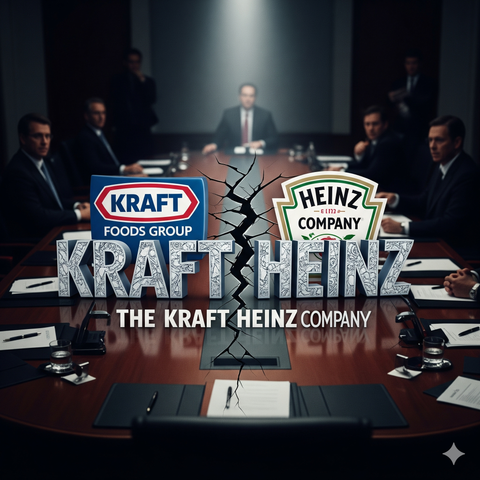Kraft-Heinz Split - Key Takeaways and Analysis

The Kraft Heinz Company
One PPG Place
Pittsburgh, PA 15222
United States
Main Phone: (412) 456-5700
Website: https://www.kraftheinzcompany.com
Industry Sector: Consumer Packaged Foods
Full Time Employees: 36,000
Fiscal Year End: Dec. 28
Annual Revenue: $25.31 Billion USD
CEO: Carlos A. Abrams-Rivera, CEO & Director
Fortune 500 Rank: #166 in 2025
Kraft Heinz’s recently announced split marks a historic turning point for one of North America’s most iconic food conglomerates. In this comprehensive Q&A, critical topics such as the timing of the split, the involvement of Warren Buffett and Berkshire Hathaway, organizational impacts, investment implications, potential leadership moves, and key guidance for technology sales professionals are all addressed with thorough business analysis and expert insights.

When Will the Kraft-Heinz Financial Split Take Place?
The financial split of Kraft Heinz is projected to finalize in the second half of 2026, pending customary regulatory approvals and completion of internal transition steps. The company will continue operating as a unified entity throughout the process to maintain business continuity. The split will result in the creation of two publicly traded companies, which will begin independently as soon as the deal closes.
Kraft Heinz Org Chart - Executive Leadership
What Are the Two New Companies and Their Focus Areas?
Post-split, Kraft Heinz will become:
- Global Taste Elevation Co.: Centered on shelf-stable meals and fast-growing international categories. Major brands include Heinz, Philadelphia, and Kraft Mac & Cheese. This company projects $15.4 billion in 2024 sales, with sauces, spreads, and seasonings comprising 75% of revenue.
- North American Grocery Co.: Focusing on core grocery staples within the region. Notable brands include Oscar Mayer, Kraft Singles, and Lunchables. This division expects $10.4 billion in 2024 net sales, most from top-positioned brands in their respective niches.
What Is Warren Buffett’s and Berkshire Hathaway’s Involvement?
Warren Buffett, through Berkshire Hathaway, has been a pivotal figure in Kraft Heinz’s history as its largest single shareholder, currently holding a 27.5% stake in the company. Alongside 3G Capital, Buffett was instrumental in the 2015 merger, which was valued at nearly $50 billion. However, Buffett now views the original merger as a costly misstep and has publicly expressed disappointment with both the merger’s long-term results and the current decision to split the company, though he ultimately accepts that the board’s move is out of Berkshire’s control.
The split has pressured Berkshire’s $8.4 billion stake, and a recent $3.76 billion write-down on Kraft Heinz significantly impacted its quarterly net income. Buffett's chosen successor, Greg Abel, has also voiced reservations, but Berkshire remains by far the largest Kraft Heinz shareholder and will be deeply affected by the financial and strategic outcomes of the breakup.
How Will the Split Affect Kraft-Heinz’s Organizational Structure?
The split is designed to dismantle a complex organizational matrix that has often hindered capital allocation, innovation, and growth. By forming two focused companies:
- Each will have dedicated management, independent boards, and tailor-made corporate teams.
- The Global Taste Elevation Co. will emphasize growth in international markets and foodservice/away-from-home channels, seeking agility to invest aggressively in global expansion.
- The North American Grocery Co. will target operational excellence, margin improvement, and leadership in grocery staples.
- CEO Carlos Abrams-Rivera is set to helm the North American Grocery Co., while a search is underway to appoint a leader for Global Taste Elevation. This leadership bifurcation is expected to drive sharper execution and clearer strategic mandates for both entities.
Is the Split a Good or Bad Situation for Investors?
Investor reaction to the announcement has been cautious and, at times, skeptical, as evidenced by a drop in Kraft Heinz’s share price immediately following the news. Several factors drive mixed investor sentiment:
POSITIVES
Enhanced strategic focus could unlock shareholder value and operational efficiency that the mega-conglomerate structure suppressed.
Distinct management teams give both companies the chance to pursue independent strategies, unhindered by competing brand priorities.
Separation often makes acquisition activity or further portfolio rationalization easier in the food industry.
NEGATIVES
The split does not guarantee sales or profit growth, especially as consumer habits shift further away from processed foods toward fresh alternatives.
Kraft Heinz has a history of underwhelming financial performance since the merger, including dividend cuts and repeated asset write-downs, raising questions about the ability of each new entity to thrive independently.
Execution risk is high, with potential for transition friction, management distraction, and significant restructuring costs in the near term.
Who Will Lead Each Company After the Split?
Carlos Abrams-Rivera (current CEO of Kraft Heinz) has been appointed CEO of the North American Grocery Co..
The board is working with an executive search firm to identify a chief executive for the Global Taste Elevation entity.
There is industry speculation about potential candidates, but no external executives or succession plans have been detailed publicly at this stage.
How Should a Technology Sales Rep Approach Kraft-Heinz Pre- and Post-Split?
Pre-Split Sales Approach
Treat Kraft Heinz as a unified entity but expect organizational flux and personnel changes during the transition.
Focus efforts on securing multi-brand, enterprise-level deals that can deliver value across Kraft Heinz’s portfolio.
Position solutions that help with business agility, data integration, and cost management—areas likely prioritized amid the upcoming operational changes.
Post-Split Sales Approach
Segment outreach and tailor messaging for the unique priorities of each company.
For North American Grocery Co., stress supply chain efficiency, regulatory compliance, and analytics to improve grocery margin and distribution performance.
For Global Taste Elevation, emphasize global market analytics, digital marketing, and innovation platforms that can accelerate international and away-from-home growth.
Identify new decision-makers and procurement structures, as both companies will redesign their internal IT/technology decision authority.
Expect increased appetite for transformation technologies in the first 1–2 years post-transaction as each entity seeks competitive advantage and operational independence.
Get the Kraft Heinz deep dive report for more seller insights, analysis, and detailed org charts. Go here
What Are the Top 5 Most Important Factors a Technology Sales Rep Needs to Know About Kraft-Heinz?
Forthcoming Split: Organizational fluidity is high. Decision-making chains and procurement processes may be disrupted, so flexibility and relationship-building are essential.
Separate Strategic Priorities: Technology investments for North American Grocery will revolve around efficiency and margin, while Global Taste Elevation will prize innovation, speed-to-market, and international scale.
Brand Complexity: Both entities will control portfolios of massive, diverse brands. Technology solutions need to support multi-brand operations, robust integration, and multi-market agility.
Transition-Related Opportunity: Both companies will seek IT and digital transformation projects to untangle legacy systems, implement independent platforms, and drive post-split competitiveness.
Financial Pressures: Recent years have seen divestitures, write-downs, and publicized cost challenges. Sales reps should address cost controls, ROI, and fast implementation to advance projects during budget-conscious phases.
Kraft Heinz’s split signals the end of an era—and the beginning of two new chapters for some of the world’s best-loved food brands. For investors, the move is a bold experiment whose success will be determined by the agility and strategic clarity of the two successor companies. For technology sales professionals, the changes ahead represent both challenge and opportunity, demanding a reimagined approach to serve, partner, and grow with these evolving industry titans.



